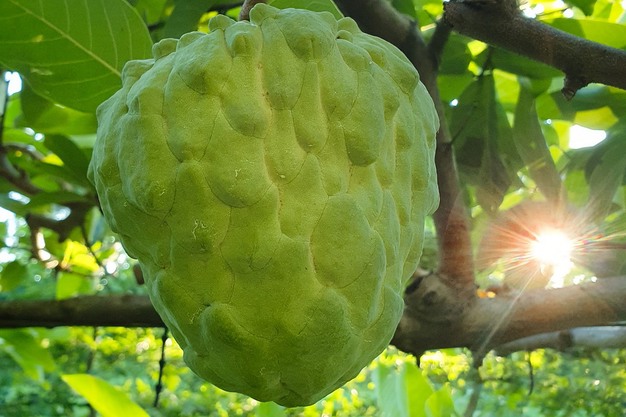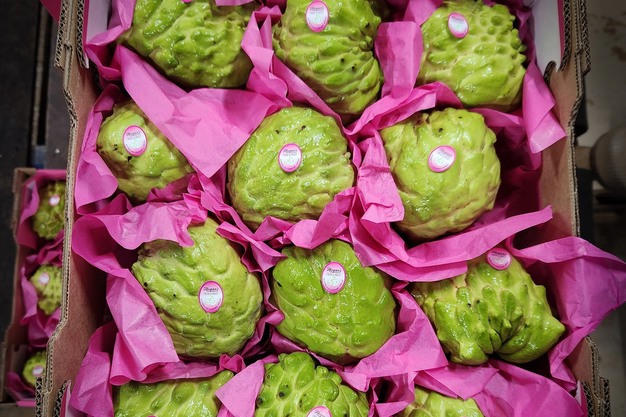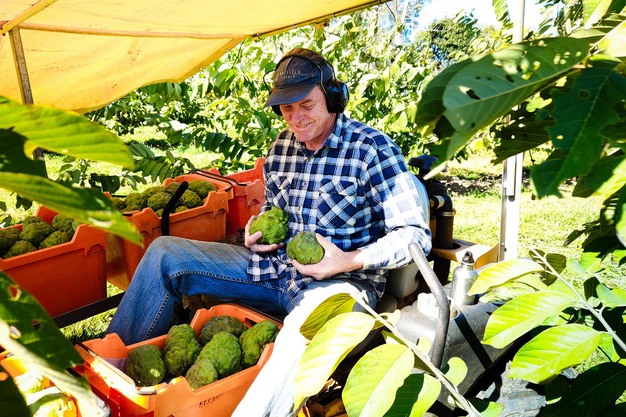A Northern NSW custard apple grower is heading into the final weeks of the season, which was a success in terms of volume and quality despite some issues with fruit splitting.
Hogan's Fresh & Sweet started harvesting in mid-April and will finish mid-September, and co-owner Cindy Hogan says the trees yielded about 4,000 trays, with about a quarter of the crop lost due to splitting during winter.
"We've sent about 3,000 trays to market," Mrs Hogan said. "The winter was wet and cold here, which was what we put the splitting down to. We've been trying to find out if there's a nutritional aspect that we can tweak to reduce splitting. The variety we grow is called KJ Pink's. It's a self-pollinating Pink's Mammoth variety and is more prone to splitting than other Pink's Mammoth varieties. They have a thin skin, not many seeds, and a tendency to be an irregular shape."

Gerard and Cindy Hogan own Hogan's Fresh & Sweet and grow the custard apples on their farm at Numulgi in the Northern Rivers of NSW, where Mrs Hogan says the soil is volcanic, and they have a subtropical climate, usually with reasonably regular rainfall.
"We have irrigation installed, and we use wide-set tree spacings on trellising. We keep vegetation strips in the inter-rows to encourage soil health as part of our orchard practice. In periods of prolonged wet weather the orchard can get boggy," she said. "We had converted a zero-turn mower into a harvest vehicle, and this year, we put axel extensions on the back, so we can use dual wheels in wet weather to reduce compaction and slipping in the orchard. We don't get frost here, but the cold wind in July-August gives the fruit a hard time, and makes the skin on the fruit a bit less attractive."
Cindy and Gerard bought the property in early 2008 and planted the first 200 African Pride custard apple trees the following year. After the African Prides went in, they planted KJ Pinks.

Mrs Hogan says another change they have made over the years has been in the growing structures. At first, they were wary of using trellising, because in those days, the trellising was all copper-arsenic treated logs, and they were concerned about possible leaching into the soil.
"We looked into alternative ideas, and decided to give concrete posts a try," Mrs Hogan said. "Nobody else was doing it then, and we had to hand-drill the holes to pass the trellis wire through the post. Some long-time growers, Phil and Patti Stacey, were also interested in the idea and also gave it a try. After that, concrete posts quickly caught on to become the usual trellis support, and they also came with pre-formed holes for the trellis wire. We've planted trees nearly every year, and now have about 1,000 trees on trellises. We pulled out the African Prides a couple of years ago. They started out well, but most of them blew over in a storm when they were young. We propped them up and pruned them back, but they were never as vigorous as the trees that didn't blow over. With trellising being a good option, and KJ Pinks being a variety that lends itself well to trellising, we decided to go with KJ Pinks for the whole farm."
The business doesn't grow any other crops on the farm, with mid-April to mid-September being the usual harvest season.
"Commercially, we're only growing KJ Pinks, but we're taking part in an industry project, along with other growers, where we're growing some of the trial trees to test out possible new varieties," Mrs Hogan said. 'We have a wholesaler in Melbourne and one in Sydney, but we haven't had the volume to consistently send to both markets in the same week, so we've only sent to Melbourne this year. The quality of the fruit was good this year, and we had mostly big fruit because we thinned hard after fruit set. Until this year, we were in a marketing group, but this year we decided to go out on our own, with a whole new look, and designed our own logo, colour scheme, boxes, stickers, the lot."

Mrs Hogan is also involved in the industry group Custard Apples Australia, where she's noticed the industry changing in recent years.
"Generally speaking, growers have more trees on their farms but there are less growers," she said. "With trellising, it's possible to have more trees per hectare, than with vase-shaped trees. Growing custard apples is labour-intensive, which puts a lot of people off growing them. At the moment, the most labour-intensive part would be the picking because the fruit needs to be picked at the correct point of maturity."
The custard apple industry in Australia has also been involved in different ways of promoting the fruit to consumers over the past twenty or so years.
"This is a big topic but briefly, consumers are becoming more aware of the fruit, and most of the customers are in metropolitan cities where the wholesale markets are," Mrs Hogan said. "Regional consumers often miss out on them. There are a few reasons for this, including the decline in the number of independently owned fruit shops, transport costs, short shelf life of custard apples and their dislike of cold storage."
 For more information
For more information
Cindy Hogan
Hogan's Fresh & Sweet
www.facebook.com/freshsweetproduce
